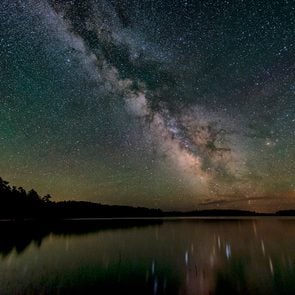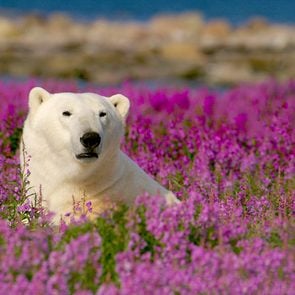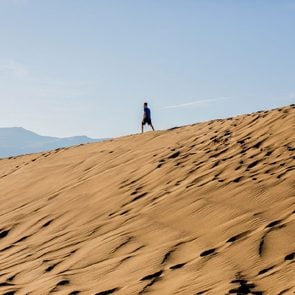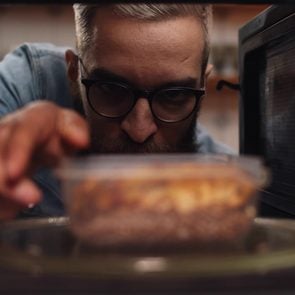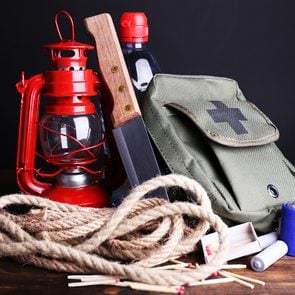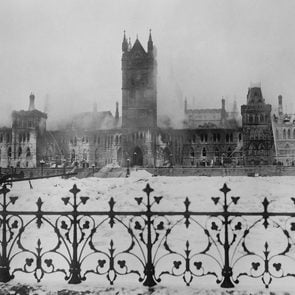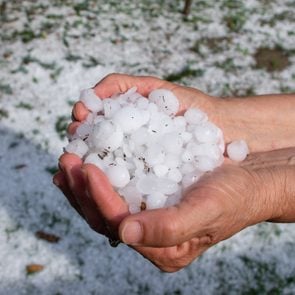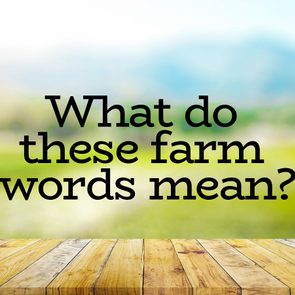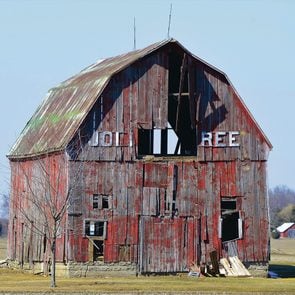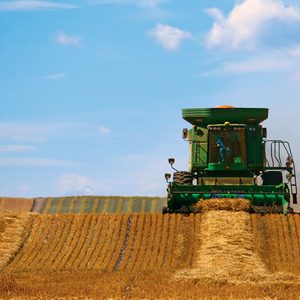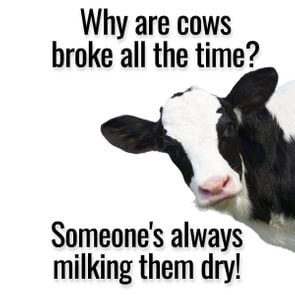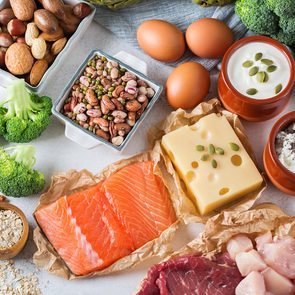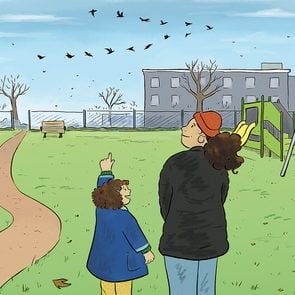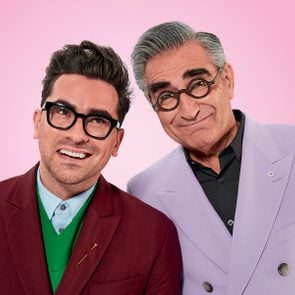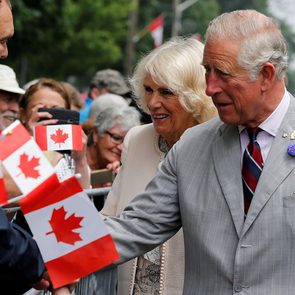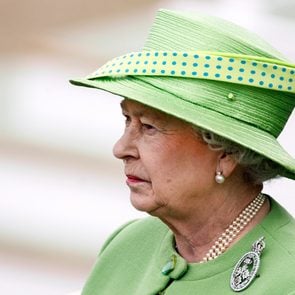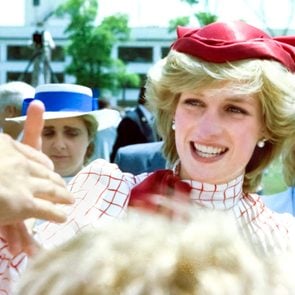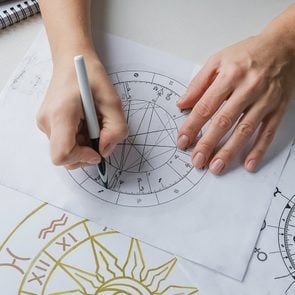Catch a Magic Show
The Indigenous-owned Aurora Village is an essential tourist attraction in the Northwest Territories, particularly if you’re obsessed with the northern lights. Located 25 minutes from Yellowknife, it comprises 21 lantern-lit teepees surrounding a glassy frozen lake, plus heated benches, a wood fire and hot drinks for optimal skygazing. An upgraded package includes a meal of smoked buffalo prime rib, bannock pudding and local N.W.T. beers and maple whisky. The best time to see the lights is between December and March, but they can show up as early as late August. Yellowknife.
Discover more great places to see the northern lights across Canada.
Praise the Painter Priest
Bern Will Brown, an Oblate priest in the Catholic church, came to Canada’s Arctic in 1948 and never left, spending the next six decades travelling by dogsled and working, alternately, as a fire warden, dog catcher, midwife, postmaster and artist. He eventually settled in the hamlet of Colville Lake, where he built a log cabin and a church, known as Our Lady of the Snows. The Bern Will Brown Museum, housed in Brown’s tiny cabin, features his paintings, fur pelts and other artifacts of an extraordinary life. Colville Lake, Northwest Territories.
Here are more historical landmarks every Canadian needs to visit.

Worship in an Igloo
In the 1950s, the missionary carpenter Maurice Lerocque chose to model Inuvik’s Our Lady of Victory church after an igloo—both to honour the local Inuit population and because the domed shape would help balance the weight of the building on the constantly shifting permafrost. His original designs—sketched on a pair of plywood planks—are still on display in the church, as are ebullient paintings by the Inuk artist Mona Thrasher. Inuvik, Northwest Territories.

Slurp Then Burp
There isn’t a lot of beef in the Northwest Territories—or pork or chicken or lamb. If you’re hungry, why not try one of the local proteins? At Bullock’s Bistro, N.W.T.’s flagship restaurant, you’re practically obligated to order the slurp ‘n’ burp: your choice of a buffalo or reindeer steak accompanied by fresh-caught pickerel (above), cod, trout or whitefish from Great Slave Lake. Yellowknife.
Explore the country’s most unique restaurants.

Behold the Bison
Sixty years ago, scientists believed the north’s bison population was all but extinct—until a new herd was discovered deep in the bush of the Northwest Territories. To preserve and protect them, 18 bison were captured and relocated to the Mackenzie Bison Sanctuary. These aren’t just any bison—they’re the last genetically pure herd on the planet. They regularly appear grazing, in all their enormous glory, along Highway 3 near Fort Providence. Fort Providence, Northwest Territories.
Now that you’ve got these tourist attractions in the Northwest Territories on your radar, check out the national parks every Canadian needs to visit.
There are a few ideas floating around on how to clean those stubborn stains on your oven window. We’ve tried using natural ingredients like vinegar, and we’ve tried a more hardcore approach with a steel wool pad and heavy-duty degreaser. Both methods worked well enough. But some people swear this clever oven cleaning trick works best of all. The secret tool? A dishwasher tablet!
How to Clean Your Oven with a Dishwasher Tablet
All you need for this hack is a dishwasher tablet (or two) and a bowl of warm water. Many have had success with the Finish powder tablets. (Just make sure whichever brand you use, that you buy the pressed powder tablets and not the gel pods.)
Dip the pod in the warm water. Hold it long enough to soak up a bit of the water, but not too long that it starts to crumble. Then, simply use the tablet to scrub, no sponge needed! Lay the tablet flat, and use your palm to move the tablet in circular motions and scrub away the stains.
Dip the tablet again if it starts to dry out. It works well on the glass, and is also effective on the surrounding metal part of the oven door (but you might need to apply a little more pressure).
When you’re finished, wipe away any residue with a damp cloth.
Why It Works
Dishwasher tablets are made of concentrated dishwasher detergent and promise to cut through tough grease and leave your dishes sparkling. It makes sense that those powerful cleaning agents work on oven grease and food stains as well! Especially since the tablets are designed to remove baked-on food; and stains in the oven are definitely baked-on. Plus, the hard powder tablets have an abrasive surface that helps to scour away on those stuck-on stains but is gentle enough not to scratch the oven glass.
Next, find out how to clean absolutely everything in your kitchen, according to Charles the Butler of CTV’s The Marilyn Denis Show.

We’ve all seen on television the devastation of summer wildfires across Canada. Back in 2020, the town of Lytton, B.C. burned to the ground; huge tracts of forest from Alberta to Ontario lost due to flames; smoke advisories across multiple provinces; firefighters from as far away as Mexico offering their aid. The list goes on.
Vancouver Island—where my wife, Cathy, and I live—escaped the worst of the 2021 wildfire season. Although we did suffer 40°C temperatures from June’s heat dome, there were no major fires on the island. Nor were there air-quality advisories due to wildfires in U.S. states to our immediate south—namely Washington, Oregon and California—as there’d been in previous summers.
We’re both in our late 60s and semi-retired. We like to go camping every summer. We stay at provincial and national parks, and absolutely love the natural surroundings these parks offer. But tourist travel simply did not happen in the summer of 2020. Even travel between municipalities was discouraged. To put it bluntly, not much of anything happened that summer—actually, make that all of 2020. I have to admit that after a year of these limitations, we were both suffering from major cabin fever.
On the Road Again
Interprovincial travel was just opening back up in the beginning of July 2021. Lockdown restrictions due to the COVID-19 pandemic were being lifted, and campgrounds were once again accepting campers. Things seemed to be getting back to some level of normalcy.
We were well aware of the fires burning in British Columbia’s Fraser Canyon. The Trans-Canada Highway was closed to all traffic due to the fire in Lytton, but highways 5 and 3—the Coquihalla and Crowsnest, respectively—were both still open, with no travel advisories or wildfire warnings along either road. We were free to choose our route for a visit to one of our favourite destinations, Banff National Park. We decided to make the trip in a clockwise direction, driving the Coquihalla on the way out and the Crowsnest back home.
We set forth on our road-and-camping trip on July 6, a Tuesday. The drive out was uneventful—until we reached Kamloops. Just east of the B.C. city’s limits, we were hit by a huge windstorm. The brown and black dust picked up from nearby hillsides was so thick that visibility was near zero. Fire-danger levels in the area had been rated as “extreme” for weeks and everything looked bone-dry. I thought that if there was a spark—even one single spark—half of the eastern end of Kamloops would burn to the ground in minutes.
Oddly enough, from Kamloops to Banff there was little, if any, indication of wildfire season. In fact, the skies were crystal clear throughout our leisurely seven-night stay in the national park. South of Banff and along Alberta’s Highway 22 (known as The Cowboy Trail), however, was a different story.
“Save Our Land”
Heading home along The Cowboy Trail, the air was smoky and hazy from new daily fires burning in southern British Columbia. You could taste the air.
Castlegar, B.C., was even worse. The smoke was so bad that the RCMP had to install LED advisory signs along Highway 3, with speed limits reduced to 70 kilometres an hour due to poor visibility.
Driving while my wife was constantly checking for road closures and wildfire conditions with DriveBC—the province’s official source for traveller information—always checking the horizon for smoke conditions and not wanting to stop anywhere for fear of being stranded was very unsettling.
But none of this prepared us for the sinking feeling that came over us as we saw the scene unfold just outside of Osoyoos, B.C., on July 20 of 2021.

The sky was an eerie shade of brown that I’d never seen before, but which I understood to be a sign of not just a forest fire, but of structures burning as well. So we knew things were bad.
The town of Osoyoos itself was dead quiet, with the few people outside on the downtown streets walking in a trancelike state. (Later, pausing at a lookout along Highway 3 on the west end of Osoyoos—pictured above—we would note that the general mood among the locals and other travellers was one of shock.)
No boats or pleasure craft of any sort were out on Osoyoos Lake, despite it being the height of tourist season. Instead, the lake was reserved for the water bombers that were repeatedly circling and refilling their tanks to fight the many ongoing fires. There were constant new flare-ups on the surrounding hillsides. Still, the water bombers’ efforts seemed futile at best. The atmosphere was almost apocalyptic.

A sight from earlier on seemed to foreshadow this scene, when we’d happened upon a striking steel sculpture of a First Nations horse rider near the eastern edge of Osoyoos, by the Petro-Canada service station at 45th Street and Highway 3. The rider is sitting atop his horse with his arm raised to the sky. The stark contrast between the blue horizon and all that thick brown smoke lasted only a few moments before the wind blended it all together.
I was so taken by that scene. It brought tears to my eyes then, and it still speaks more than a thousand words today. To me, it appeared as though the rider was crying out to the Creator and Great Spirit: “Please help save our land!”
The horse and rider sculpture is one of many created by Indigenous artist Virgil “Smoker” Marchand. A similar statue welcomes visitors to the nearby Nk’Mip Desert Cultural Centre, in Osoyoos.
Next, read the terrifying story of the deadliest forest fire in Canada’s history.
My mother married a farmer: my father. A tenet spoon-fed to my sister and me along with our baby cereal was “Don’t marry a farmer!” Long hours, no sick days, income dependent on the weather, little to no holiday time—Mother’s list was extensive. So what did I do? I married a farmer.
Perfecting the art of field meals
One of my tasks during seeding and harvest time is to take meals to the field. On paper, it doesn’t sound like such an arduous undertaking. I admit that when I first started taking the odd meal to the field, the offerings were uninspired. My husband jokes that during one harvest season, all he ever ate for lunch were Pizza Pops. He isn’t wrong. Working part-time off the farm and caring for our two small, very busy sons meant that planning a gourmet feast that would transport easily was out of the question. My husband’s options were pretty much take it or leave it. That’s why my mother-in-law was primarily in charge of field cuisine.
I marvelled at the ease with which she managed the job. Field meals were delicious, desserts were even better and time was actually taken to sit down and eat. Lawn chairs were set up, a buffet was laid out on a truck tailgate and my father-in-law would allot a half-hour from a busy day to mealtime. My husband, who is more of a “Gimme the lunch bag so I can get going” kind of guy, likely chafed at the enforced inactivity, but my father-in-law was wise and knew the value of taking a break during those stressful, deadline days.

The passage of time has meant that I’m now responsible for field meals. Sadly, lawn-chair lunches are a thing of the past, but with the children now grown, I have more opportunity to experiment with food choices. Of course, some elements always need to be considered when planning meals to be eaten aboard farm equipment. The ideal field meals need to be portable and to be able to be eaten using only one hand—without falling apart or without falling off a fork when shovelled in. Cappelletti casserole? A sure winner. Barbecued bacon cheeseburgers? Full marks. As for other options—well, I can now say with absolute certainty that a hot chicken pot pie on a 37-plus degree day was a mistake. That’s when the bologna sandwich and bottle of water would have been the more prudent choice.
A well-oiled machine?
We’ve had some notable mishaps with field meals over the years. For one, timing is everything when hauling meals to the field. Depending on where my husband and older son are working, it may mean setting out at 11:30 a.m. in order to arrive punctually at noon—though there’s no guarantee anyone will be there to pick up lunch. They could be working at the other end of the quarter section while I wait, my brilliant culinary offering growing cold despite the microwave-heated Magic Bag trying to keep it warm—and yes, I know the manufacturer didn’t intend for it to be used in this fashion!

In another instance, my younger son was tasked with taking some chicken burgers to his father. In my hurry, I forgot to put the burgers in an insulated bag, so, wrapped in tinfoil, they rode to the field on the hot dash of the truck. The trouble came when my son took a corner too sharply and the burgers sailed out through the open window, giving a whole new meaning to “fast food.” They actually survived the initial impact—but one of them was no match for a rear tire. My husband was presented with one dusty and dented burger, along with a battered object that resembled a foil-wrapped CD. But, being practical and hungry, he ate them both.
Another time, in a spectacular display of meal mismanagement, I accidentally set the microwave timer for too long, got busy filling containers and packing lunch bags, and roasted a Magic Bag beyond salvation. The stench was indescribable.

Collecting lunch supplies after a long day can also be a challenge. One never knows in which piece of equipment the bags might end up; and there’s no guarantee that, despite sending out four reusable containers, all four will be returned. Sometimes, carriers end up in grain trucks, tossed into the back seats of half-tons or wedged under tractor seats. And there’s no cleaner on the market up to the task of disinfecting a sealed container of half-eaten lasagna after a week of being bounced around in summer heat. Those receptacles are simply considered lost in the line of duty, given their due respect…and tossed into a burning barrel.
Field meals are a cherished tradition
Seeding and harvest. Planting and reaping. These are but two of the many seasons in the grain-and-cattle-farming year. Despite the occasional blunder on my end, I really do enjoy being a part of those two seasons, even if in just a small way.
Today, my older son is a fourth-generation farmer. Born five months before the end of the life of the great-grandfather whose surname he bears, he only vaguely remembers the days of lawn-chair lunches, when he would go with Gramma to the field, sit in the back of the truck and snitch cookies, and crawl onto Papa’s knee and listen to the morning’s stories.
Many aspects of agriculture have changed over those four generations—but to me, it’s important that the tradition of feeding those who feed the rest of us remains the same.
Next, check out a stunning gallery showcasing the Canadian Prairies.
Our family owns and operates Anvic Farms—a beef cattle farm here in Alliston, Ontario. In August of 2020, we bought our very first Canadienne cow. Ten years before, we had learned of the existence of this rare dairy breed that was first brought to North America from Brittany and Normandy and developed in French Canada.
Canadienne cattle were very popular on dairy farms in Canada—mainly Quebec, as this breed of cow was known for being able to handle the harsh cold winter weather, as well as being able to convert lesser quality forage into rich milk. The breed flourished for several decades, before the arrival of other dairy breeds such as Holstein and Jersey. The Canadienne remains the only dairy breed developed in Canada and today, there are only about 300 heads of this purebred left in the country.
Our Canadienne cow (above), named Little Farm Colonel Rayna—Rayna for short, was bred to a Charolais bull in September 2020, after her arrival on the farm but unfortunately had a stillbirth in July 2021. We decided to give her a foster calf, a Holstein bull, which she cares for today.
Rayna is also the face of my blog about agriculture, largely due to her unique features and amazing ancestral history. She blends in well with our beef cows and eats only about one-third of what a beef cow of her age eats, despite giving milk. Rayna also walks really well on a halter, which makes her a great candidate for my endless photoshoots with her. Rayna is featured prominently on our farm’s Facebook page, as well as my own website where she shares the front cover with me.
Having a Canadienne cow on our farm has been a dream of ours for a very long time, and she has been well worth it. In 2022, Rayna was bred to a Limousin bull on the farm. One day, we hope to add more Canadienne cattle to our herd and have a diverse mix of beef and dairy cattle.
Next, check out 10 Canadian history podcasts worth adding to your playlist.
We’ll admit that cottage cheese is not the most attractive food. Yet look beyond its wet, lumpy appearance to the health benefits of cottage cheese, not to mention its versatility as an ingredient, and its status as a nutritional powerhouse quickly emerges. But exactly what is cottage cheese?
“Cottage cheese is a type of cheese that is known for its lumpy or curd-like texture,” explains Jordan Hill, RD, a registered dietitian with Top Nutrition Coaching. You’ll find it in the dairy aisle next to the ricotta cheese (which is made from whey, while cottage cheese is made from curds) and the sour cream (which is made by fermenting regular cream).
In its simplest form, the ingredients involved in cottage cheese are milk and an acid. “Cottage cheese is made by coagulating milk with an acidic substance, such as lemon juice or vinegar, and then separating the curds from the whey,” says Hill. “The curds are the solid portions of the milk that clump together, while the whey is the liquid portion that is drained off.”
The benefits of cottage cheese
The popularity of cottage cheese as a healthy food peaked in the early 1970s, and since then, it has steadily declined while the popularity of yogurt has skyrocketed (largely due to the massive marketing push yogurt has received). But cottage cheese is making a comeback, primarily on TikTok, and for good reason: It’s still as healthy as it was 50 years ago.
“Cottage cheese is not a new food, but it has been rediscovered by people as a higher-protein, lower-fat, lower-cost food,” says Hill. “And for those reasons, it’s catching wind again.”
The cheese has its manufacturing process to thank for its coveted high-protein content. “During the coagulation process, the proteins in milk, primarily casein, form the curds,” Hill explains. “These curds are retained in cottage cheese, providing a higher concentration of protein compared to other cheeses, where the curds are often removed.”
Indeed, 1 cup of cottage cheese contains a whopping 25 grams of protein, roughly the same amount as a 3-ounce grilled chicken breast. Plus, you have the option of purchasing fat-free, 1%, 2% or whole-fat versions. “Because of the higher protein and varying fat options of cottage cheese, it can be a satiating and versatile food at a lower calorie ‘cost,'” explains Hill. “Cottage cheese also has little to no saturated fat or added sugar, nutrients that if eaten in excess can increase the risk for certain chronic diseases.”
Learn to spot the signs you’re not getting enough protein.

How to add more cottage cheese to your diet
Just like many frozen foods, cottage cheese works well both by itself and incorporated into recipes. You can eat it in many of the same ways that you would eat yogurt, such as in a parfait.
If you want to get the protein boost from cottage cheese but you’re not a fan of the texture, simply pulse it in a blender or food processor to smooth out the curds before spooning it into a bowl. “Layer cottage cheese with fresh fruits like berries, sliced peaches or pineapple chunks,” Hill suggests. “Top with a drizzle of honey and a sprinkle of granola or chopped nuts for added crunch.”
Cottage cheese can also be incorporated into many recipes or used as a substitute for ricotta or cream cheese if you’re looking to up the protein content of your dish. Some of Hill’s favourite cottage cheese recipes include:
- Cottage cheese pancakes: “Replace some or all of the flour in your pancake recipe with cottage cheese,” she says. “This adds protein and a creamy texture. Blend the cottage cheese into the batter for a smoother consistency.”
- Cottage cheese muffins: “Incorporate cottage cheese into muffin batter for added moisture and protein. Try adding it to recipes like blueberry muffins or bran muffins,” Hill suggests.
- Cottage cheese lasagna: “Use cottage cheese instead of ricotta in your lasagna layers,” she says. “Layer it with tomato sauce, lasagna noodles and your choice of vegetables and cheeses.”
Now that you’re familiar with the benefits of cottage cheese, check out our ultimate guide to healthy grocery shopping.

In our search for that ‘just right’ night’s sleep, many of us have turned to memory foam mattresses, which offer great comfort, pinpointed pressure relief and support. Yet, they have a notorious downside—memory foam mattresses tend to trap heat, leaving us sweltering instead of snoozing.
That’s where Octave comes in. Packed with the latest and most advanced cooling technologies and foam advancements, Octave’s specialty mattress lineup is primed to keep you comfortably snoozing all night.
Octave, home to Canada’s best specialty foam mattresses, not only addresses the issue of heat-trapping associated with traditional memory foam but also enhances the features that made us fall in love with memory foam in the first place, like motion isolation and pressure point relief. Let’s explore how Octave is changing the game in the world of sleep.
Advanced Cooling Unleashed
From the get-go, Octave doesn’t mess around. Every mattress in the brand’s lineup, starting from the entry-level Octave Vista, is a masterclass in thoughtful design—multiple layers of premium specialty foams infused with advanced cooling features dotted throughout the mattress guarantee sweat-free slumber.

A refreshing coolness washes over you the minute you lie down on Octave’s bespoke top cover. This machine-washable cover, infused to the brim with cooling nanofibres, will make you feel like you’ve stepped into a breezy oasis. But the chill factor doesn’t stop there.
Just underneath that cool cover, the Vista has a layer of copper gel memory foam treated with phase-change materials. While copper actively pulls away any excess heat, the phase-change material helps keep your body at the perfect temperature throughout the night. Plus, the sturdy high-density base foam isn’t just for support—it’s designed with air channels for constant ventilation and airflow.
Sleep Undisturbed
Let’s face it, we all want a mattress that helps you stay asleep throughout the night, even when your partner is thrashing in their sleep and performing the macarena. For many of us, finding a mattress with excellent motion isolation is key and foam mattresses are popular for that very reason, but Octave takes it up a notch.
How? It’s all in the layers. Octave mattresses have been meticulously designed and are exclusively made with specialty foams—like premium Elastex® foam or aerated Talalay latex layers to cushion and conform to your shoulders, back, and hips. Its high-density base foam is engineered to provide exceptional motion isolation, which is critical to a great night’s sleep.

These layers, each with a unique role, work together to give you a sleep that’s as steady and pressure-relieving as it gets. So, if you’re dreaming of a slumber that’s uninterrupted and oh-so-comfortable, Octave has got you covered.
Where to Snooze in Comfort
Octave offers three distinct mattress models, each designed purely with specialty foams, to deliver a tailored sleep experience. Prices for Octave Vista, our top pick and Canada’s best specialty foam mattress, start at a dreamy price of $599, which is an absolute steal for a specialty foam mattress!
Can’t wait to dive into the world of Octave? Good news: this top-tier comfort is proudly crafted right here in Canada and just a few clicks away.
With free shipping to most parts of Canada, an impressive 365-night sleep trial, a 15-year warranty, and a FREE bedding bundle (includes two pillows and pillow protectors, a sheet set, and a mattress protector), getting an Octave mattress is a no-brainer. Get yours at OctaveSleep.ca.

As a Sunday school teacher, I always enjoyed teaching young elementary students a series of lessons about Moses leading the children of Israel out of Egypt. I must have shown my enthusiasm. One day a young girl quietly asked me, “Do you remember him?” —Ralph Dillenbeck, Bow Island, Alberta
My husband was a professional violinist and once performed at our son’s school. Some of the students sent him letters of appreciation. One eight- year-old wrote, “Dear Mr. Violinist, thank you so much for coming to play for our school when you could have been doing something more useful.” —Margaret Growcott, Port Alberni, B.C.
My three-year-old’s favourite game is Restaurant, which just entails her putting on a chef’s hat and me ordering dessert. No matter what I order, she says, “We don’t have that.” —@missmulrooney
My kids know I’m asthmatic and very allergic to cats.
Older daughter: “I don’t like cats because mommy’s allergic to them.”
Younger daughter: “When mommy dies, I’m getting a cat!” —@Meena
A Grade 3 student of mine asked if he could get ice from the office for his sore neck. I wrote his name on an office form, jotted down the reason he was going there and dispatched him with the note. I belatedly realized the secretary could misinterpret why he was there, considering I merely wrote “severe pain in the neck.” —Lena Desjardins, Oakville, Ontario
I was cooking dinner when my six-year-old came in and told me she was writing a song called “What’s that burning smell coming from the kitchen?” Then she walked out, banging her tambourine. —@MumInBits
My son walked into the kitchen and said, “I bet you don’t know what 47 divided by 4 is.” I told him it was 11, remainder 3. He said thanks and walked back to the room in which he was doing his homework. —@DevonESawa
My three-year-old granddaughter and I were playing a board game. I explained that the “3+” label on the box meant anyone aged three or older could play the game. The next game we played, she turned the box over. Seeing the first number on the bar code was a nine, she said, “I can’t play!” —Mary-Lynne Stordy, Aurora, Ontario
My five-year-old grandson got some new shoes. I asked him if he liked them, and he said, “I love them but I have to take really small steps.” He lifted his feet to show me. The shoes were still as they had come from the store, with the laces tied together. —Greg Wilmot, Pitt Meadows, B.C.
Here, more grandparents reveal the funniest things their grandkids have said.

My daughter is still getting to grips with the “Would You Rather…?” game. Today she asked me if I’d rather be eaten by a shark or have lovely dinners every day. —@dadofthreeblogs
My son asked me if I would tell his grandma how to cut strawberries the “right way.” —@bekindofwitty
My nine-year-old has wanted to bake a cake for weeks, and today after I finished work we finally did it. Being so busy means it’s easy to forget about making memories with my kids. I can tell she loved every one of the four minutes of it before she went to watch TV and left me to do it all. —@threetimedaddy
My six-year-old granddaughter wanted to play a computer game with me. I told her I had never played it before and she would have to teach me how. She replied, “That’s alright, Grandma. It would be my honour to teach you.” —Amanada Mcleod, Salt Spring Island, B.C.
Me: Don’t open the oven door.
My seven-year-old: I just want to see.
Me: Those are meringue cookies. If you open the oven door for anything, they will crack.
My seven-year-old: What if the cat opens the oven door with his paws, gets inside, closes the door behind him and is trapped? Can we open the oven door to save him? —@michaelvogel1
Is putting your feet in the bathtub while your kid takes a bath and tries to stick toys between your toes considered a pedicure? I’m just going to say it is and try to feel pampered. —Carrie Underwood, singer
My 13-year-old said she was sick of relatives asking her, “How’s school?” I wanted to know what she would prefer, and she said she wants to be asked if there’s any drama at school. —@copymama
One year my younger sister and a friend went door-to-door with trick-or-treat bags several days before Halloween. When told it wasn’t actually Halloween yet, my sister replied, “We were practicing!” —Elaine Parks, Toronto
I sent my daughter a text and she responded with, “I will look into this. Thank you.” So I guess we’re business associates now. —@_wendyb07
A simple way to get my kids to brush their teeth and do their homework: if they don’t, they have to be a guest on my podcast. —Conan O’Brien, comedian
While taking my five-year-old to his friend’s birthday party, he decided to use the birthday card to squish a bug in the car. His friend is getting a little extra surprise this year. —@kevinthedad

My six-year-old said that when she grows up she wants to be a “chainsaw guy.” Not sure if she means a professional tree trimmer or a serial killer in a hockey mask. —@xplodingunicorn
When my four-year-old came out of school today his teacher said he’d been a bit quiet and not like his usual self. I asked my son what was the matter. He said, “I’m just uncharged today. I used all my energy playing. Can I charge some more tonight?” —reddit.com
On my 12-year-old’s list of things to be thankful for, she wrote, “People who like me, not just the idea of me.” I’m sorry, but that’s genius. —Busy Philipps, actor
My daughter told me a boy in school asked her out.
Me: What did you say?
My eight-year-old: I said I can speak three languages and was the lead in my camp’s play, and what could he offer? —@panagis21
My seven-year-old: Dad, why don’t you grow a beard?
My husband: Your mom wouldn’t like it if I did.
My seven-year-old: Oh, would she be jealous because she can’t grow one? —@wordesse
The funniest thing that ever happened to me as a parent was when my two-year-old had a meltdown and accidentally kicked an electronic toy dinosaur. It said, “Can you feed me?” and my son, through massive sobs, said, “No, I can’t right now, dinosaur,” and continued screaming. —Lucy Huber, writer
My seven-year-old, sweetly: Can we have peace and quiet?
My five-year-old, furiously: No! I want peace and loud! —@lizerreal
I tripped over my kid’s shoes in the middle of the floor, and she said it was my fault because I should have known they are always there. —@mcdadstuff
After I tucked my three-year-old into bed, he handed me his water cup and said, “You can freshen this on your way out.” I’ve since updated my résumé to reflect my experience running a hotel. —@fullofmomsense
My twins learned some new adjectives at school today and are currently arguing about whether the dinner I cooked is abominable or diabolical. —@muminbits
One of my students asked me, “Why do you have a bald spot that goes right down the middle of your head?” I have no baldness. It was my hair part. —reddit.com
While at the aquarium, my kid asked me, “The sharks aren’t allowed to eat the other fish, right?” So if anyone asks, aquarium sharks are vegetarian. —@notmythirdrodeo
My toddler is pretending to cook a meal and it involves a lot of screaming and throwing food in a pot. Which means she gets it. —@mommajessiec
Check out the funniest comedies on Netflix right now.

If you’re unable to handle rejection, then you shouldn’t be in showbiz or a parent. —Scott Porteous, Winnipeg
The price of gas made me cave and get my six-year-old that pony for her birthday. —@devonesawa
Accomplish whatever tasks you have today with the confidence of a kid who claims to have brushed their teeth. —@homewithpeanut
My daughter told me that my belly is squishier than a pillow, so I’ll be accepting applications for a new heir. —@katiedeal99
Me: How’s your pancake?
My three-year-old rubbing the pancake on his face: It’s soft. —@notmythirdrodeo
My five-year-old daughter is confident, happy and not afraid to speak her mind. All these amazing qualities come out at once when she announces to her entire class that she has to poop. —@gfishandnuggets
My daughter just learned about evolution and is now mourning that she didn’t morph from a kitten. —@mom_tho
I’m trying to be grateful for one thing each day. Today I’m grateful that my kids are old enough to make their own dinner after they tell me they hate my cooking. —@sweetmomissa
Love when kids rename things. For example, my kids call snacks “nackies,” granola bars “nolas” and homemade meals “do we have anything else to eat?” —@mommajessiec
Me: We’re going to a surprise party today.
My six-year-old: For me?
Me: No. It’s not your birthday.
My six-year-old: I know. I would be surprised. —@xplodingunicorn
My five-year-old got in the car this morning and asked if we “should roll the windows down and party” and I think I need to approach everything with that level of energy from now on. —@whinecheezits
If I ever want to hear about all the injustice in the world, I just ask my 12-year-old to clear the table after dinner. —@threetimedaddy
Ninety per cent of parenting is convincing your children to participate in basic life necessities. Eat. Sleep. Shower. Repeat. —@kidversations_
My daughter can’t find her glasses, her shoes or her backpack, but she can spot a sliver of onion in a bowl of rice from 10 feet away.
—@six_pack_mom
I told my kids they had to share a doughnut and they whipped out a ruler, protractor, scale and magnifying glass. —@struggledisplay
Parenting tip: To keep your kids quiet in the car, let them throw the crumbs from their seats out the window for the birds. For 10 minutes my car was quiet and now it’s a little cleaner. —@fullofmonsense
No parenting book can prepare you for when your three-year-old literally sticks her finger in your nostril and says, “Hey Mom, smell this!” —@wordesse
My son just said IKEA is grown-up Legos and I’ve never felt more connected and seen. —@anagasteyer
Check out more hilarious tweets every parent can relate to.

The Life and Legacy of Queen Elizabeth II
On her 21st birthday, the future Queen Elizabeth II set the tone for the rest of her long and remarkable life in a radio broadcast, pledging to the Commonwealth, “I declare before you all that my whole life, whether it be long or short, shall be devoted to your service and the service of our great imperial family to which we all belong.”
It was 1947, and Elizabeth was on her first overseas tour, visiting South Africa and what is now Zimbabwe with her parents King George VI and Queen Elizabeth (later the Queen Mother) and her younger sister, Princess Margaret. The speech became one of the iconic moments in Elizabeth’s life, quoted during the major milestones of her reign, and performed by Claire Foy during the third season of The Crown on Netflix.
As Queen Elizabeth II, she presided over the final transition from the British Empire to a Commonwealth of equal nations, exercising subtle diplomatic influence in her role as Head of the Commonwealth. Throughout her reign, the Queen set an example of duty and public service, committed to her role as Queen of more than a dozen Commonwealth realms including Canada, Australia, New Zealand and numerous countries in the Caribbean and South Pacific. She became the best travelled monarch in history, embracing opportunities to connect with people from all walks of life from around the world.

The Young Princess
Elizabeth was not born to be Queen. When Princess Elizabeth Alexandra Mary of York was born at the London home of her maternal grandparents on April 21, 1926, her grandfather reigned as King George V, but her father, then Prince Albert, Duke of York, was only the king’s second son. Following the First World War, George V had granted his children permission to marry members of the British aristocracy (instead of foreign royalty alone) and the Duke of York had wed Lady Elizabeth Bowes-Lyon, the daughter of the Scottish Earl and Countess of Strathmore. The Duke and Duchess of York carried out royal duties and royal tours, but the Duke’s elder brother was expected to one day reign as King Edward VIII, make a suitable marriage and father children of his own. The birth of Princess Elizabeth was overshadowed in the news by a general strike in the United Kingdom that lasted for nine days. Nevertheless, there was intense popular interest in the young Elizabeth and her sister Margaret Rose, who was born in 1930.
The young princess had a happy childhood. The Duke and Duchess of York and their children were a close family who enjoyed spending time together in their home on Piccadilly Street near Hyde Park in London. The princesses were educated at home by a Scottish governess, Marion Crawford, and a series of French governesses. The schedule of lessons was undemanding, and the princesses enjoyed long summer holidays in Scotland and time spent with both sets of grandparents and their extended family. Elizabeth was passionate about dogs, horses and spending time in countryside; interests that she would maintain throughout her life. Compared to her playful younger sister Margaret, Elizabeth was serious and conscientious from a young age. Future British Prime Minister Winston Churchill observed when Elizabeth was a toddler, “She has an air of authority and reflectiveness astonishing in an infant.”
Don’t miss our ultimate guide to royal residences.

Abdication and War
Princess Elizabeth’s life changed forever in 1936, known as the “Year of Three Kings.” In the span of that year, her grandfather George V died, her uncle Edward VIII abdicated to marry the twice-divorced American Wallis Simpson, and her father unexpectedly succeeded to the throne as King George VI (the name signifying continuity with the previous generation). Elizabeth moved into Buckingham Palace with her parents and sister and there were rumours that she reacted to the news of her uncle’s abdication by praying for a baby brother who would displace her as first in the line of succession.
The new King and Queen made efforts ensure their daughters would have some experiences in common with other girls their own age. As members of a Buckingham Palace Girl Guide Company, the princesses learned to pitch tents and make campfires in the vast palace gardens. Despite this, Elizabeth was increasingly aware of her responsibilities as heiress presumptive. Her widowed grandmother Queen Mary shared her love of royal history and took both Elizabeth and Margaret to historical sites while the provost of Eton College at Windsor gave Elizabeth lessons in constitutional history. Her education as a future Queen, however, came largely from shadowing her father George VI and learning from his example.
Elizabeth and Margaret spent the Second World War at Windsor Castle while their parents stayed at Buckingham Palace on weekdays and travelled widely to visit bomb-damaged communities and encourage the war effort. During the Blitz, the Windsor Castle windows were blacked out and the medieval dungeons were repurposed as bomb shelters. Elizabeth played a role in the war effort herself. At 14, she delivered her first radio broadcast, addressing the children of the Commonwealth, including British evacuees who were far from home, stating, “We know, every one of us, that in the end all will be well; for God will care for us and give us victory and peace. And when peace comes, remember it will be for us, the children of today, to make the world of tomorrow a better and happier place.” At 16, she became honourary Colonel-in-Chief of the Grenadier Guards and undertook her first solo public engagement reviewing the troops. At 18, she joined the Auxiliary Territorial service as a Second Subaltern, where she trained as a mechanic and was soon promoted to Junior Commander.

A Royal Romance
The war also provided opportunities for Elizabeth to spend time with Prince Philip of Greece and Denmark, an officer in the royal navy five years her senior who visited Windsor Castle while on leave.
Elizabeth had first noticed her distant cousin during a tour of Dartmouth Naval College in 1939 and they corresponded while Philip was on active service. One of Elizabeth’s Scottish cousins, Margaret Rhodes, later recalled, “Princess Elizabeth was enamoured from an early age. I’ve got letters from her saying, ‘It’s so exciting. Mummy says ‘Philip can come and stay.’’” After the war, Philip and Elizabeth enjoyed drives in the countryside and visits to the theatre including a performance of the musical Oklahoma!.
Their engagement was announced after the royal family’s return from South Africa in 1947 and they were married at Westminster Abbey on November 20 that same year. The marriage lasted for 73 years until Philip’s death on April 9, 2021. On their Golden Anniversary in 1997, the Queen reflected on her marriage in a speech at the London Guildhall, stating, “He is someone who doesn’t take easily to compliments but he has, quite simply, been my strength and stay all these years, and I, and his whole family, and this and many other countries, owe him a debt greater than he would ever claim, or we shall ever know.”
Prince Philip almost always accompanied the Queen when she travelled outside the United Kingdom. Princess Elizabeth first visited Canada in 1951 with Prince Philip, representing King George VI who was unable to travel because he had just had surgery for lung cancer. The young Princess was impressed by Canada, stating in a speech, “From the moment when I set foot on Canadian soil…I knew myself to be not only amongst friends but amongst fellow countrymen.” The young princess seemed serious compared to her smiling husband as she was worried about her father’s health, but there were lighthearted moments on the tour, including a square dance at Rideau Hall and a trip to the Calgary Stampede where Elizabeth wore the mink coat that had been one of her official wedding gifts from Canada.
Take a look back at Queen Elizabeth’s incredible life in photos.

The Young Queen
On February 6, 1952, George VI died in his sleep from thrombosis following years of declining health, exacerbated by heavy smoking. The new Queen Elizabeth II was with Prince Philip at the Treetops Safari Lodge in Kenya on a royal tour that was supposed to continue across the Indian Ocean to Australia and New Zealand. Philip broke the news to his wife and the royal party immediately returned to London. The Queen Mother wrote to her mother-in-law, Queen Mary, “I cannot bear to think of Lilibet, so young to bear such a burden.” The Queen received widespread public sympathy and approval for her quiet dignity in mourning and the photograph of the three Queens in black was published in newspapers around the world. The Queen’s grandson, Prince William, stated at the time of the Diamond Jubilee, “Back then, there was a very different attitude to women. Being a young lady at 25—and stepping into a job which many men thought they could probably do better—it must have been very daunting. And I think there was extra pressure for her to perform.”
Elizabeth was crowned Queen in Westminster Abbey on June 2, 1953. The coronation service dated back to the reign of the Anglo-Saxon King Edgar the Peaceable in 973 AD, and the Queen would mark the 1,000th anniversary of this milestone at Bath Abbey in 1973. The Queen was the first monarch to be crowned as sovereign of each of the Commonwealth realms, including the Queen of Canada. The coronation symbolized a lifelong commitment: a marriage between sovereign and people and, in contrast to several of her contemporaries on continental European thrones, the Queen would never consider abdication. There was a key modern innovation at Queen Elizabeth II’s coronation, however: the presence of television cameras in the Abbey, allowing millions of people around the world to watch the service and share in the celebrations. Over the course of her reign, the Queen found innovative ways to the connect with the public, whether it was televising the annual Christmas message, inviting film crews to capture moments in the daily lives of the royal family in a 1969 documentary or reviving the royal walkabout, which had been so successful during her parents’ visit to the Cenotaph in Ottawa during their 1939 Royal Tour of Canada.
Check out Britain’s 10 most memorable coronations.
Queen Elizabeth II became the most well-travelled monarch in history. She would visit Canada more often than other Commonwealth realm outside the United Kingdom, undertaking 22 official visits including opening Parliament in 1957, opening the St. Lawrence Seaway with American president Dwight Eisenhower in 1959, attending Expo 67 in Montreal and signing the patriation of the constitution with Prime Minister Pierre Trudeau in 1982. During the Queen’s reign, Canada emerged as one of the world’s most welcoming countries for immigrants; a place where diverse cultural and religious traditions could peacefully coexist. The Queen praised the Canadian spirit of multiculturalism in a 1973 speech at the Royal York Hotel in Toronto, stating, “I am here as Queen of Canada, and all Canadians—not just one or two ancestral strains.” The speech was well received by the Canadian public. Not all the Queen’s Canadian tours were as successful. In 1964, she faced protestors in Quebec who associated the monarchy with British oppression. In the 1990s, the Queen’s tours of Canada were sometimes overshadowed by the visits of her children and salacious headlines concerning the breakdowns of their marriages.
Here are 10 Canadian hotels that have hosted royal guests.

Royal Family Life
The Queen and Prince Philip had four children: Prince Charles (later Prince of Wales and now King Charles III, born 1948), Princess Anne (later Princess Royal, born 1950), Prince Andrew (later Duke of York, born 1960) and Prince Edward (later Earl of Wessex, born 1964). The family would gradually expand to include eight grandchildren and a dozen great-grandchildren. The royal couple enjoyed spending time with their children, especially Christmases at Sandringham House in Norfolk, summer holidays at Balmoral Castle in Scotland and cruises on the Royal Yacht Britannia (now a museum ship in Leith Harbour). The Queen adjusted the timing of her weekly meeting with the British Prime Minister to ensure that she was present at bedtime when her children her young. In private, the Queen was known for her sense of humour and was an excellent mimic.
There were many disruptions to the Queen’s family life, however. First Prince Philip’s naval career, then a busy schedule of royal duties including the extended Commonwealth tours of the 1950s and 1960s, often separated the Queen from her children for long periods of time. Unlike the Queen and her sister, this new generation of royal children were educated outside the home, attending boarding schools, which Charles found to be a particularly miserable experience. The Queen left many decisions regarding her children’s education and upbringing to Philip and was not inclined to closely manage them as adults, allowing them to make their own decisions as they grew older. This relaxed approach was critiqued in the press when the Queen’s children experienced difficulties in their domestic lives. The respective marriages of Charles to Lady Diana Spencer, Andrew to Sarah Ferguson and Anne to Mark Phillips all ended in divorce, and royal scandals received unrelenting press coverage that undermined the reputation of the royal family. In 1992, the year of Anne’s divorce, Andrew’s separation, the publication of Diana: Her True Story by Andrew Morton and a devastating fire at Windsor Castle, the Queen reflected in a speech, “1992 is not a year on which I shall look back with undiluted pleasure. In the words of one of my more sympathetic correspondents, it has turned out to be an annus horribillis.”

Queen and Commonwealth
While the press was fascinated by life behind palace doors, Queen Elizabeth II continued her schedule of public engagements and Commonwealth tours. As a constitutional monarch, she was obliged to act on the advice of her British Prime Ministers in the United Kingdom—but her role as Head of the Commonwealth provided opportunities for quiet diplomatic influence on the world stage. Despite the reservations of some of her Prime Ministers, the Queen was present for Commonwealth Heads of Government meetings from 1973 when she accepted an invitation to the Ottawa meeting on the advice of her Canadian Prime Minister at the time, Pierre Trudeau. (The Queen joked at the 2015 Commonwealth Heads of Government meeting in Malta that the new Canadian Prime Minister, Justin Trudeau, made her “feel so old” when he referred to royal tours during his father’s time.) At these biennial meetings, the Queen introduced the leaders of newly independent countries to seasoned politicians, encouraging networking and joint initiatives amongst Commonwealth nations. In 1985, in a meeting in Nassau that was dramatized in Season 4 of The Crown on Netflix, the Queen worked with Commonwealth leaders to pressure South Africa to end apartheid. Former Prime Minister Brian Mulroney later recalled in an interview with The Toronto Star, “[The Queen] and I became quite close during the fight to free [Nelson] Mandela. She was very unhappy, as you know, with the British government’s position, as articulated by Margaret (Thatcher).”
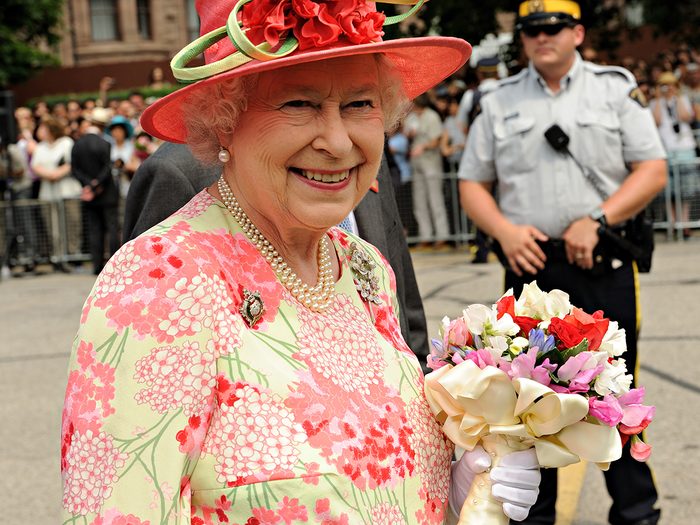
A Monarch’s Milestones
In the 21st century, Queen Elizabeth II celebrated key milestones in her reign: The Golden Jubilee in 2002, the Diamond Jubilee in 2012, and the Platinum Jubilee in 2022. While the monarchy had been criticized and scrutinized in the 1990s, these celebrations of the anniversaries of the Queen’s accession to the throne were met with an outpouring of acclaim for her decades of public service.
For the Queen, the Golden Jubilee celebrations were tempered by the deaths of two of her closest family members. Both Queen Elizabeth the Queen Mother and Princess Margaret died in 2002. Despite her grief at the loss of her mother and sister, the Queen and Prince Philip embarked on a busy schedule of Commonwealth tours to mark the Golden Jubilee, travelling to Australia, New Zealand, Jamaica and Canada.
The Queen visited Canada for the last time in 2010, celebrating Canada Day on Parliament Hill and prompting a resurgence of popular interest in the monarchy in Canada. At an official dinner in Toronto in the Queen’s honour, Prime Minister Stephen Harper delivered a speech filled with hockey metaphors in which he praised the Queen as Canada’s “Most Valuable Player.”
In 2011, the Queen visited Australia for the last time, where she gave a speech at the Perth Commonwealth Heads of Government Meeting. Addressing the meeting’s theme, “Women as Agents of Change,” the Queen stated, “We must continue to strive in our own countries and across the Commonwealth together to promote that theme in a lasting way beyond this year.” The speech was widely viewed as a quiet endorsement of the introduction of a gender-neutral line of succession in the United Kingdom and Commonwealth realms where the eldest child of the monarch, male or female, would succeed to the throne regardless of the presence of younger brothers.

A Record-Breaking Reign
By the Diamond Jubilee of 2012, the Queen and Prince Philip had limited their engagements to within the United Kingdom while their children and grandchildren undertook the Commonwealth tours which had been central to the Queen’s schedule for decades. The Queen and Prince Philip gradually passed their charitable patronages to the next generation as well. Charles and his eldest son William performed investitures and accompanied the Queen to official events, especially after Philip’s retirement from public life in 2017.
On September 9, 2015, the Queen became the longest reigning monarch in British and Commonwealth history, surpassing the previous record set by her great-great-grandmother Queen Victoria in 1897. Like Victoria, Elizabeth marked the historic milestone quietly—in the company of grandchildren and great-grandchildren—at Balmoral Castle in Scotland. While Victoria became longest reigning monarch during a visit from her granddaughter, Empress Alexandra of Russia, grandson-in-law Czar Nicholas II and their baby daughter Grand Duchess Olga, Elizabeth hosted her grandson Prince William (now Prince of Wales), his wife Catherine, Duchess of Cambridge (now Princess of Wales), and their children Prince George and Princess Charlotte.
The Queen had provided advice and support for William during the breakdown of his parents’ marriage, inviting him to lunch at Windsor Castle on weekends when he was attending nearby Eton College for secondary school. William praised his grandmother at the time of her Diamond Jubilee, saying “My relationship with my grandmother has gone from strength to strength.” The Queen approved of William’s marriage to Catherine Middleton in 2011, the first woman from a middle-class background to marry a direct heir to the throne since 1660.
Victoria had been the matriarch of an extended family of European royal houses. Elizabeth presided over a royal family that was increasingly relatable to the public as her grandchildren undertook independent careers and married spouses from a variety of backgrounds, setting the tone for the future of the monarchy in the 21st century.
During the COVID-19 pandemic, the Queen drew parallels between the crisis and the Second World War. In a speech broadcast from Windsor Castle, 80 years after her wartime address to the children of the Commonwealth, the Queen declared, “[My sister and I] as children spoke from here at Windsor to children who had been evacuated from their homes and sent away for their own safety. Today, once again, many will feel a painful sense of separation from their loved ones, but now as then, we know deep down that it is the right thing to do. While we have faced challenges before, this one is different. This time we join with all nations across the globe in a common endeavour.”

Looking to the Future
On November 14, 2021, the widowed Queen was absent “with great regret” at the National Service of Remembrance at the Cenotaph in London. Her son Charles, who turned 73 that day, laid the first wreath on her behalf.
Charles had spent most of his life as heir to the throne, observing his mother’s example and gradually assuming her busy schedule of overseas tours and public engagements. Although the Queen made efforts to ensure that the eventual transition from one reign to another would be straightforward, the question of the future monarch’s role as Head of the Commonwealth was less certain.
In 2018, the Queen attended her last Commonwealth Heads of Government Meeting, hosted at Buckingham Palace and Windsor Castle. The meeting celebrated the Queen’s decades of service to the Commonwealth and looked to the future. In a speech to Commonwealth leaders, the Queen emphasized the importance of a smooth transition, stating, “It is my sincere wish that the Commonwealth will continue to offer stability and continuity to future generations and will decide one day the Prince of Wales should carry on the important work started by my father in 1949.”
As King Charles III, Charles will build upon Queen Elizabeth II’s tireless example of duty and public service as the sovereign and Head of the Commonwealth.
Next, take a look back at the Queen’s extraordinary life in 30 quotes.
Whether you’re an authoritative Aries or a caring Cancer, every zodiac sign has its attractive traits. These astrological measurements can even predict everything from your romantic compatibility, to your biggest fears, to your ideal dog breed. But when it comes to intelligence, which sign has the most brains?
The Smartest Zodiac Sign
The smartest zodiac sign is actually a tie between Aquarius and Scorpio, astrologists say—but they share the top spot for two very different reasons. Those born under the Aquarius sign have the highest levels of analytical intelligence, which is measured by cognitive ability and IQ. Scorpios, on the other hand, have more perceptive smarts; they are best at realistically assessing and understanding the world at large.
That’s not to say that other zodiac signs aren’t intelligent in their own ways. In fact, Geminis and Libras have plenty of mental smarts too, according to Neil Crabtree, an astrologist at the Mayo School of Astrology. Cancer and Pisces are the most emotionally intelligent; in other words, they are excel at recognizing and reasoning with their own and others’ feelings.
On the other hand, the earth signs—Taurus, Virgo, and Capricorn—demonstrate practical intelligence. And the fire signs (Aries, Leo, and Sagittarius) tend to be the most intuitive, making them more inclined to take risks and fill leadership positions.
Now that you know the smartest zodiac sign, find out the most (and least!) polite zodiac signs.
